Talent Management Strategies and Project Report: Dyson Case Study
VerifiedAdded on 2022/11/30
|31
|6996
|277
Report
AI Summary
This report provides a comprehensive analysis of talent management strategies, focusing on the case of Dyson. It begins with an introduction to the importance of talent management in modern organizations, highlighting the role of the HR department and the significance of talent management strategies in attracting and retaining skilled employees. The report then outlines the aims and objectives of the research, which include understanding the concepts, examining Dyson's strategies, and evaluating the challenges. A literature review provides context, discussing talent management concepts, strategies used by Dyson, and associated challenges. The report then details a project management plan, outlining constraints such as time, cost, quality, scope, communication, and risk. It also includes a work breakdown structure and Gantt chart. The research involves small-scale qualitative and quantitative research, followed by an evaluation of the research and data using appropriate tools and techniques. The report concludes with recommendations based on the research analysis and a reflection on the project's value, including a project logbook and performance review templates in the appendices.
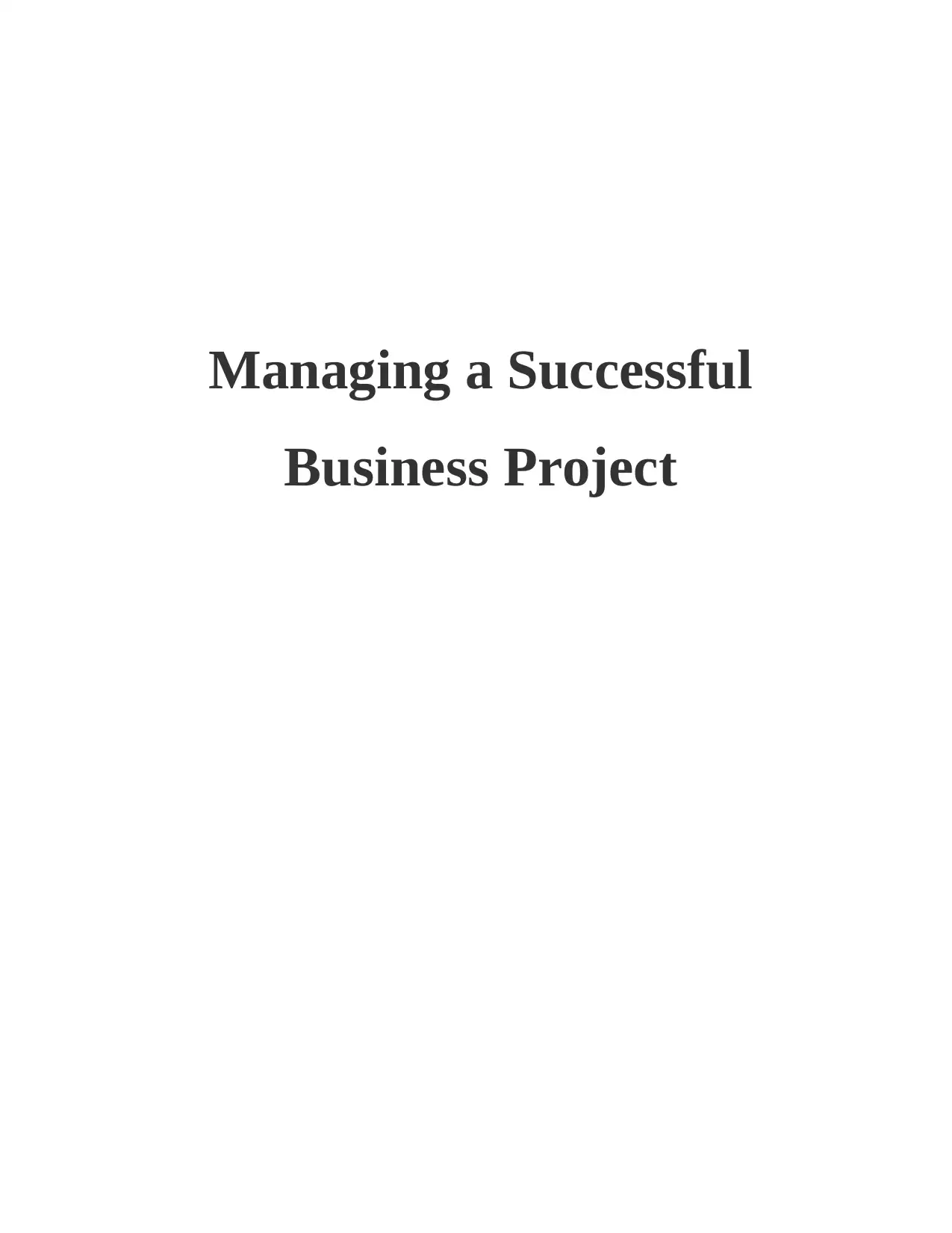
Managing a Successful
Business Project
Business Project
Paraphrase This Document
Need a fresh take? Get an instant paraphrase of this document with our AI Paraphraser
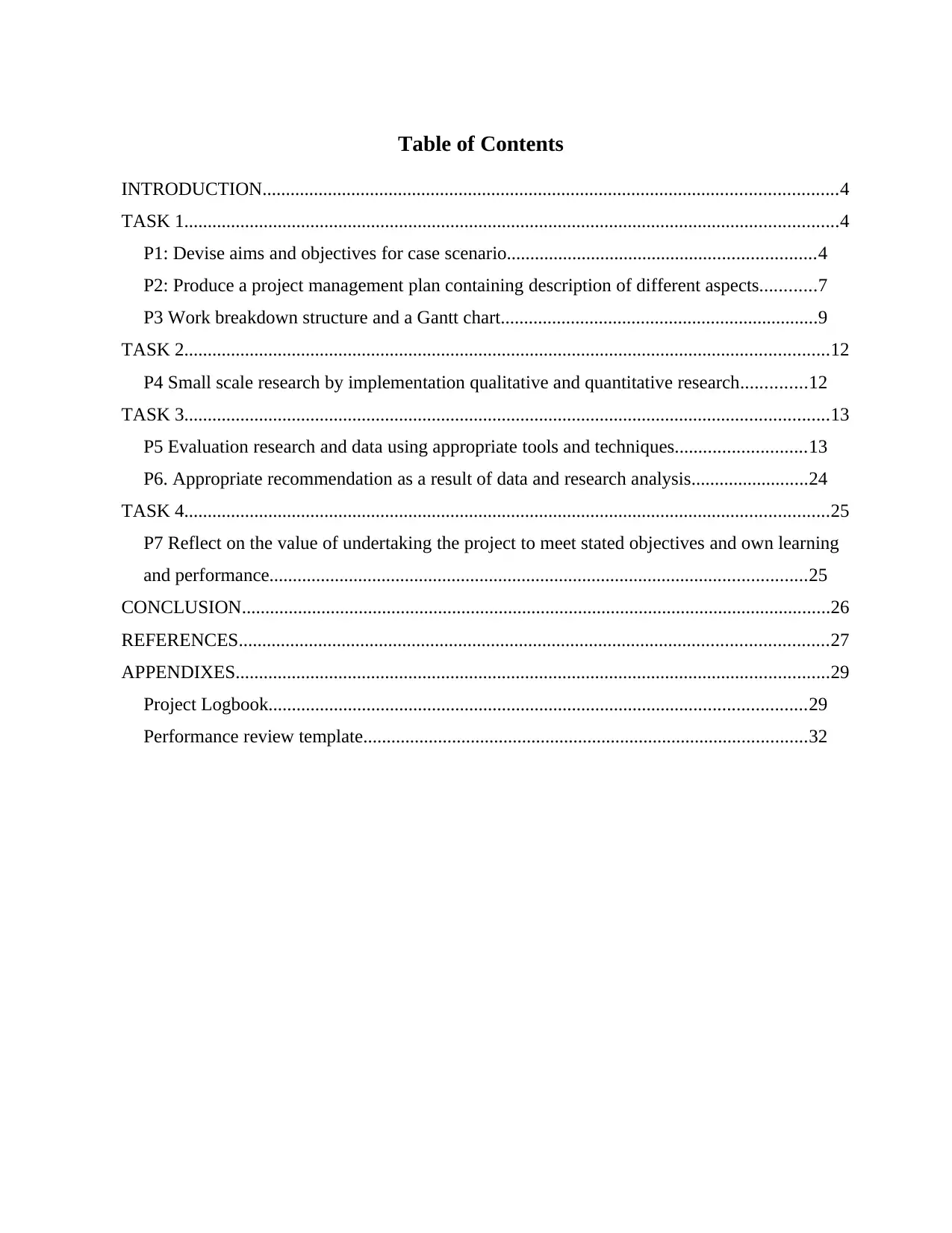
Table of Contents
INTRODUCTION...........................................................................................................................4
TASK 1............................................................................................................................................4
P1: Devise aims and objectives for case scenario..................................................................4
P2: Produce a project management plan containing description of different aspects............7
P3 Work breakdown structure and a Gantt chart....................................................................9
TASK 2..........................................................................................................................................12
P4 Small scale research by implementation qualitative and quantitative research..............12
TASK 3..........................................................................................................................................13
P5 Evaluation research and data using appropriate tools and techniques............................13
P6. Appropriate recommendation as a result of data and research analysis.........................24
TASK 4..........................................................................................................................................25
P7 Reflect on the value of undertaking the project to meet stated objectives and own learning
and performance...................................................................................................................25
CONCLUSION..............................................................................................................................26
REFERENCES..............................................................................................................................27
APPENDIXES...............................................................................................................................29
Project Logbook...................................................................................................................29
Performance review template...............................................................................................32
INTRODUCTION...........................................................................................................................4
TASK 1............................................................................................................................................4
P1: Devise aims and objectives for case scenario..................................................................4
P2: Produce a project management plan containing description of different aspects............7
P3 Work breakdown structure and a Gantt chart....................................................................9
TASK 2..........................................................................................................................................12
P4 Small scale research by implementation qualitative and quantitative research..............12
TASK 3..........................................................................................................................................13
P5 Evaluation research and data using appropriate tools and techniques............................13
P6. Appropriate recommendation as a result of data and research analysis.........................24
TASK 4..........................................................................................................................................25
P7 Reflect on the value of undertaking the project to meet stated objectives and own learning
and performance...................................................................................................................25
CONCLUSION..............................................................................................................................26
REFERENCES..............................................................................................................................27
APPENDIXES...............................................................................................................................29
Project Logbook...................................................................................................................29
Performance review template...............................................................................................32
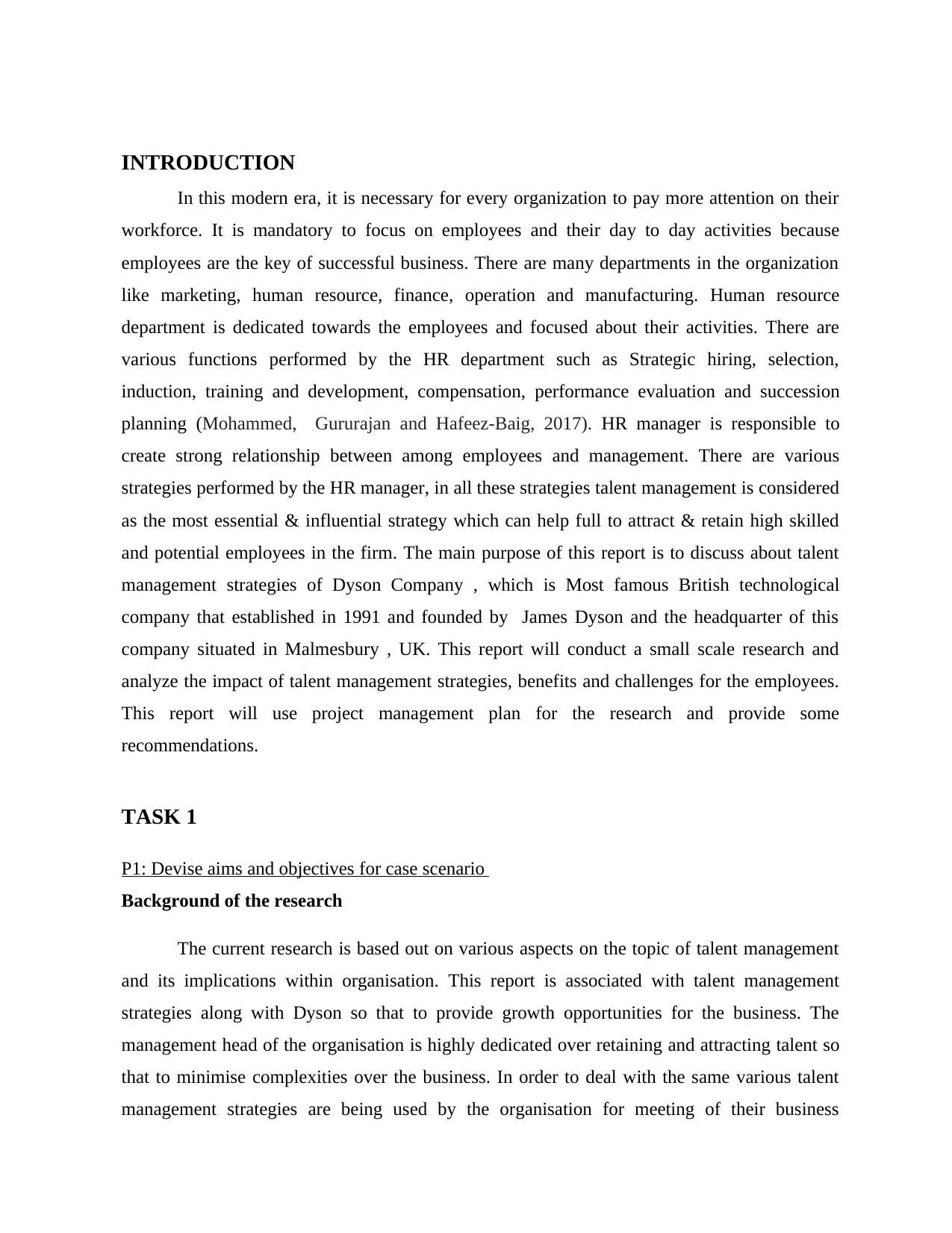
INTRODUCTION
In this modern era, it is necessary for every organization to pay more attention on their
workforce. It is mandatory to focus on employees and their day to day activities because
employees are the key of successful business. There are many departments in the organization
like marketing, human resource, finance, operation and manufacturing. Human resource
department is dedicated towards the employees and focused about their activities. There are
various functions performed by the HR department such as Strategic hiring, selection,
induction, training and development, compensation, performance evaluation and succession
planning (Mohammed, Gururajan and Hafeez-Baig, 2017). HR manager is responsible to
create strong relationship between among employees and management. There are various
strategies performed by the HR manager, in all these strategies talent management is considered
as the most essential & influential strategy which can help full to attract & retain high skilled
and potential employees in the firm. The main purpose of this report is to discuss about talent
management strategies of Dyson Company , which is Most famous British technological
company that established in 1991 and founded by James Dyson and the headquarter of this
company situated in Malmesbury , UK. This report will conduct a small scale research and
analyze the impact of talent management strategies, benefits and challenges for the employees.
This report will use project management plan for the research and provide some
recommendations.
TASK 1
P1: Devise aims and objectives for case scenario
Background of the research
The current research is based out on various aspects on the topic of talent management
and its implications within organisation. This report is associated with talent management
strategies along with Dyson so that to provide growth opportunities for the business. The
management head of the organisation is highly dedicated over retaining and attracting talent so
that to minimise complexities over the business. In order to deal with the same various talent
management strategies are being used by the organisation for meeting of their business
In this modern era, it is necessary for every organization to pay more attention on their
workforce. It is mandatory to focus on employees and their day to day activities because
employees are the key of successful business. There are many departments in the organization
like marketing, human resource, finance, operation and manufacturing. Human resource
department is dedicated towards the employees and focused about their activities. There are
various functions performed by the HR department such as Strategic hiring, selection,
induction, training and development, compensation, performance evaluation and succession
planning (Mohammed, Gururajan and Hafeez-Baig, 2017). HR manager is responsible to
create strong relationship between among employees and management. There are various
strategies performed by the HR manager, in all these strategies talent management is considered
as the most essential & influential strategy which can help full to attract & retain high skilled
and potential employees in the firm. The main purpose of this report is to discuss about talent
management strategies of Dyson Company , which is Most famous British technological
company that established in 1991 and founded by James Dyson and the headquarter of this
company situated in Malmesbury , UK. This report will conduct a small scale research and
analyze the impact of talent management strategies, benefits and challenges for the employees.
This report will use project management plan for the research and provide some
recommendations.
TASK 1
P1: Devise aims and objectives for case scenario
Background of the research
The current research is based out on various aspects on the topic of talent management
and its implications within organisation. This report is associated with talent management
strategies along with Dyson so that to provide growth opportunities for the business. The
management head of the organisation is highly dedicated over retaining and attracting talent so
that to minimise complexities over the business. In order to deal with the same various talent
management strategies are being used by the organisation for meeting of their business
⊘ This is a preview!⊘
Do you want full access?
Subscribe today to unlock all pages.

Trusted by 1+ million students worldwide
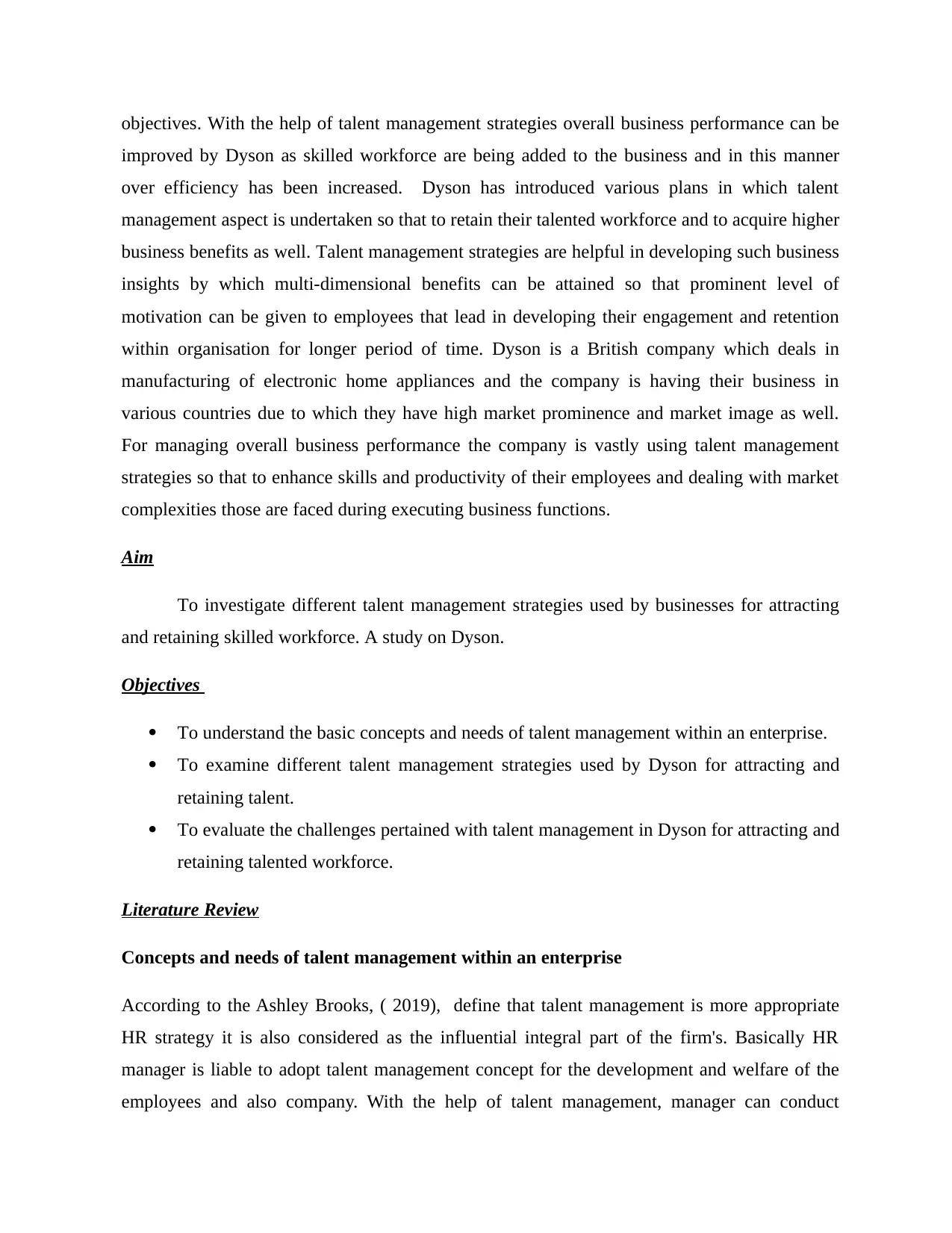
objectives. With the help of talent management strategies overall business performance can be
improved by Dyson as skilled workforce are being added to the business and in this manner
over efficiency has been increased. Dyson has introduced various plans in which talent
management aspect is undertaken so that to retain their talented workforce and to acquire higher
business benefits as well. Talent management strategies are helpful in developing such business
insights by which multi-dimensional benefits can be attained so that prominent level of
motivation can be given to employees that lead in developing their engagement and retention
within organisation for longer period of time. Dyson is a British company which deals in
manufacturing of electronic home appliances and the company is having their business in
various countries due to which they have high market prominence and market image as well.
For managing overall business performance the company is vastly using talent management
strategies so that to enhance skills and productivity of their employees and dealing with market
complexities those are faced during executing business functions.
Aim
To investigate different talent management strategies used by businesses for attracting
and retaining skilled workforce. A study on Dyson.
Objectives
To understand the basic concepts and needs of talent management within an enterprise.
To examine different talent management strategies used by Dyson for attracting and
retaining talent.
To evaluate the challenges pertained with talent management in Dyson for attracting and
retaining talented workforce.
Literature Review
Concepts and needs of talent management within an enterprise
According to the Ashley Brooks, ( 2019), define that talent management is more appropriate
HR strategy it is also considered as the influential integral part of the firm's. Basically HR
manager is liable to adopt talent management concept for the development and welfare of the
employees and also company. With the help of talent management, manager can conduct
improved by Dyson as skilled workforce are being added to the business and in this manner
over efficiency has been increased. Dyson has introduced various plans in which talent
management aspect is undertaken so that to retain their talented workforce and to acquire higher
business benefits as well. Talent management strategies are helpful in developing such business
insights by which multi-dimensional benefits can be attained so that prominent level of
motivation can be given to employees that lead in developing their engagement and retention
within organisation for longer period of time. Dyson is a British company which deals in
manufacturing of electronic home appliances and the company is having their business in
various countries due to which they have high market prominence and market image as well.
For managing overall business performance the company is vastly using talent management
strategies so that to enhance skills and productivity of their employees and dealing with market
complexities those are faced during executing business functions.
Aim
To investigate different talent management strategies used by businesses for attracting
and retaining skilled workforce. A study on Dyson.
Objectives
To understand the basic concepts and needs of talent management within an enterprise.
To examine different talent management strategies used by Dyson for attracting and
retaining talent.
To evaluate the challenges pertained with talent management in Dyson for attracting and
retaining talented workforce.
Literature Review
Concepts and needs of talent management within an enterprise
According to the Ashley Brooks, ( 2019), define that talent management is more appropriate
HR strategy it is also considered as the influential integral part of the firm's. Basically HR
manager is liable to adopt talent management concept for the development and welfare of the
employees and also company. With the help of talent management, manager can conduct
Paraphrase This Document
Need a fresh take? Get an instant paraphrase of this document with our AI Paraphraser
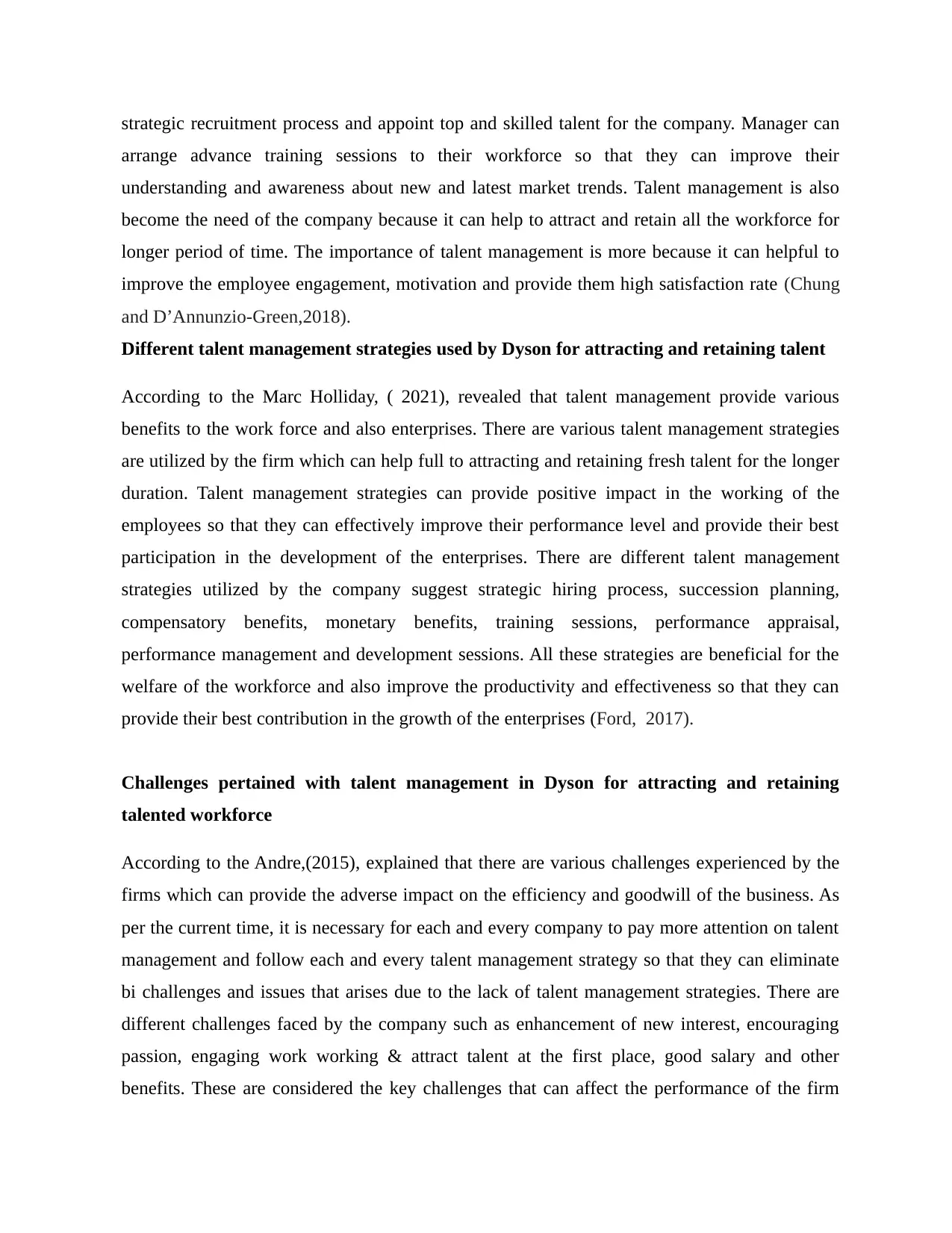
strategic recruitment process and appoint top and skilled talent for the company. Manager can
arrange advance training sessions to their workforce so that they can improve their
understanding and awareness about new and latest market trends. Talent management is also
become the need of the company because it can help to attract and retain all the workforce for
longer period of time. The importance of talent management is more because it can helpful to
improve the employee engagement, motivation and provide them high satisfaction rate (Chung
and D’Annunzio-Green,2018).
Different talent management strategies used by Dyson for attracting and retaining talent
According to the Marc Holliday, ( 2021), revealed that talent management provide various
benefits to the work force and also enterprises. There are various talent management strategies
are utilized by the firm which can help full to attracting and retaining fresh talent for the longer
duration. Talent management strategies can provide positive impact in the working of the
employees so that they can effectively improve their performance level and provide their best
participation in the development of the enterprises. There are different talent management
strategies utilized by the company suggest strategic hiring process, succession planning,
compensatory benefits, monetary benefits, training sessions, performance appraisal,
performance management and development sessions. All these strategies are beneficial for the
welfare of the workforce and also improve the productivity and effectiveness so that they can
provide their best contribution in the growth of the enterprises (Ford, 2017).
Challenges pertained with talent management in Dyson for attracting and retaining
talented workforce
According to the Andre,(2015), explained that there are various challenges experienced by the
firms which can provide the adverse impact on the efficiency and goodwill of the business. As
per the current time, it is necessary for each and every company to pay more attention on talent
management and follow each and every talent management strategy so that they can eliminate
bi challenges and issues that arises due to the lack of talent management strategies. There are
different challenges faced by the company such as enhancement of new interest, encouraging
passion, engaging work working & attract talent at the first place, good salary and other
benefits. These are considered the key challenges that can affect the performance of the firm
arrange advance training sessions to their workforce so that they can improve their
understanding and awareness about new and latest market trends. Talent management is also
become the need of the company because it can help to attract and retain all the workforce for
longer period of time. The importance of talent management is more because it can helpful to
improve the employee engagement, motivation and provide them high satisfaction rate (Chung
and D’Annunzio-Green,2018).
Different talent management strategies used by Dyson for attracting and retaining talent
According to the Marc Holliday, ( 2021), revealed that talent management provide various
benefits to the work force and also enterprises. There are various talent management strategies
are utilized by the firm which can help full to attracting and retaining fresh talent for the longer
duration. Talent management strategies can provide positive impact in the working of the
employees so that they can effectively improve their performance level and provide their best
participation in the development of the enterprises. There are different talent management
strategies utilized by the company suggest strategic hiring process, succession planning,
compensatory benefits, monetary benefits, training sessions, performance appraisal,
performance management and development sessions. All these strategies are beneficial for the
welfare of the workforce and also improve the productivity and effectiveness so that they can
provide their best contribution in the growth of the enterprises (Ford, 2017).
Challenges pertained with talent management in Dyson for attracting and retaining
talented workforce
According to the Andre,(2015), explained that there are various challenges experienced by the
firms which can provide the adverse impact on the efficiency and goodwill of the business. As
per the current time, it is necessary for each and every company to pay more attention on talent
management and follow each and every talent management strategy so that they can eliminate
bi challenges and issues that arises due to the lack of talent management strategies. There are
different challenges faced by the company such as enhancement of new interest, encouraging
passion, engaging work working & attract talent at the first place, good salary and other
benefits. These are considered the key challenges that can affect the performance of the firm
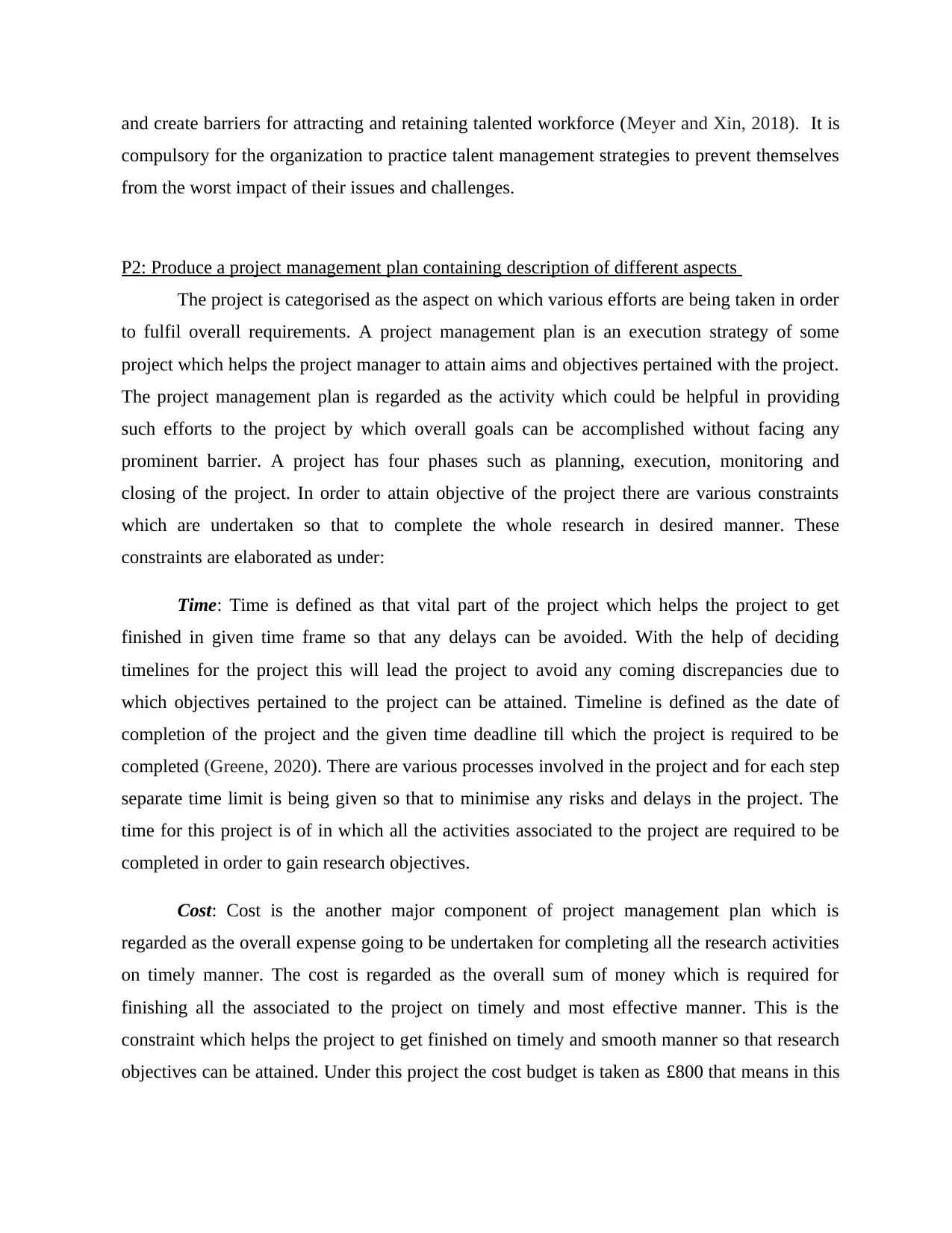
and create barriers for attracting and retaining talented workforce (Meyer and Xin, 2018). It is
compulsory for the organization to practice talent management strategies to prevent themselves
from the worst impact of their issues and challenges.
P2: Produce a project management plan containing description of different aspects
The project is categorised as the aspect on which various efforts are being taken in order
to fulfil overall requirements. A project management plan is an execution strategy of some
project which helps the project manager to attain aims and objectives pertained with the project.
The project management plan is regarded as the activity which could be helpful in providing
such efforts to the project by which overall goals can be accomplished without facing any
prominent barrier. A project has four phases such as planning, execution, monitoring and
closing of the project. In order to attain objective of the project there are various constraints
which are undertaken so that to complete the whole research in desired manner. These
constraints are elaborated as under:
Time: Time is defined as that vital part of the project which helps the project to get
finished in given time frame so that any delays can be avoided. With the help of deciding
timelines for the project this will lead the project to avoid any coming discrepancies due to
which objectives pertained to the project can be attained. Timeline is defined as the date of
completion of the project and the given time deadline till which the project is required to be
completed (Greene, 2020). There are various processes involved in the project and for each step
separate time limit is being given so that to minimise any risks and delays in the project. The
time for this project is of in which all the activities associated to the project are required to be
completed in order to gain research objectives.
Cost: Cost is the another major component of project management plan which is
regarded as the overall expense going to be undertaken for completing all the research activities
on timely manner. The cost is regarded as the overall sum of money which is required for
finishing all the associated to the project on timely and most effective manner. This is the
constraint which helps the project to get finished on timely and smooth manner so that research
objectives can be attained. Under this project the cost budget is taken as £800 that means in this
compulsory for the organization to practice talent management strategies to prevent themselves
from the worst impact of their issues and challenges.
P2: Produce a project management plan containing description of different aspects
The project is categorised as the aspect on which various efforts are being taken in order
to fulfil overall requirements. A project management plan is an execution strategy of some
project which helps the project manager to attain aims and objectives pertained with the project.
The project management plan is regarded as the activity which could be helpful in providing
such efforts to the project by which overall goals can be accomplished without facing any
prominent barrier. A project has four phases such as planning, execution, monitoring and
closing of the project. In order to attain objective of the project there are various constraints
which are undertaken so that to complete the whole research in desired manner. These
constraints are elaborated as under:
Time: Time is defined as that vital part of the project which helps the project to get
finished in given time frame so that any delays can be avoided. With the help of deciding
timelines for the project this will lead the project to avoid any coming discrepancies due to
which objectives pertained to the project can be attained. Timeline is defined as the date of
completion of the project and the given time deadline till which the project is required to be
completed (Greene, 2020). There are various processes involved in the project and for each step
separate time limit is being given so that to minimise any risks and delays in the project. The
time for this project is of in which all the activities associated to the project are required to be
completed in order to gain research objectives.
Cost: Cost is the another major component of project management plan which is
regarded as the overall expense going to be undertaken for completing all the research activities
on timely manner. The cost is regarded as the overall sum of money which is required for
finishing all the associated to the project on timely and most effective manner. This is the
constraint which helps the project to get finished on timely and smooth manner so that research
objectives can be attained. Under this project the cost budget is taken as £800 that means in this
⊘ This is a preview!⊘
Do you want full access?
Subscribe today to unlock all pages.

Trusted by 1+ million students worldwide
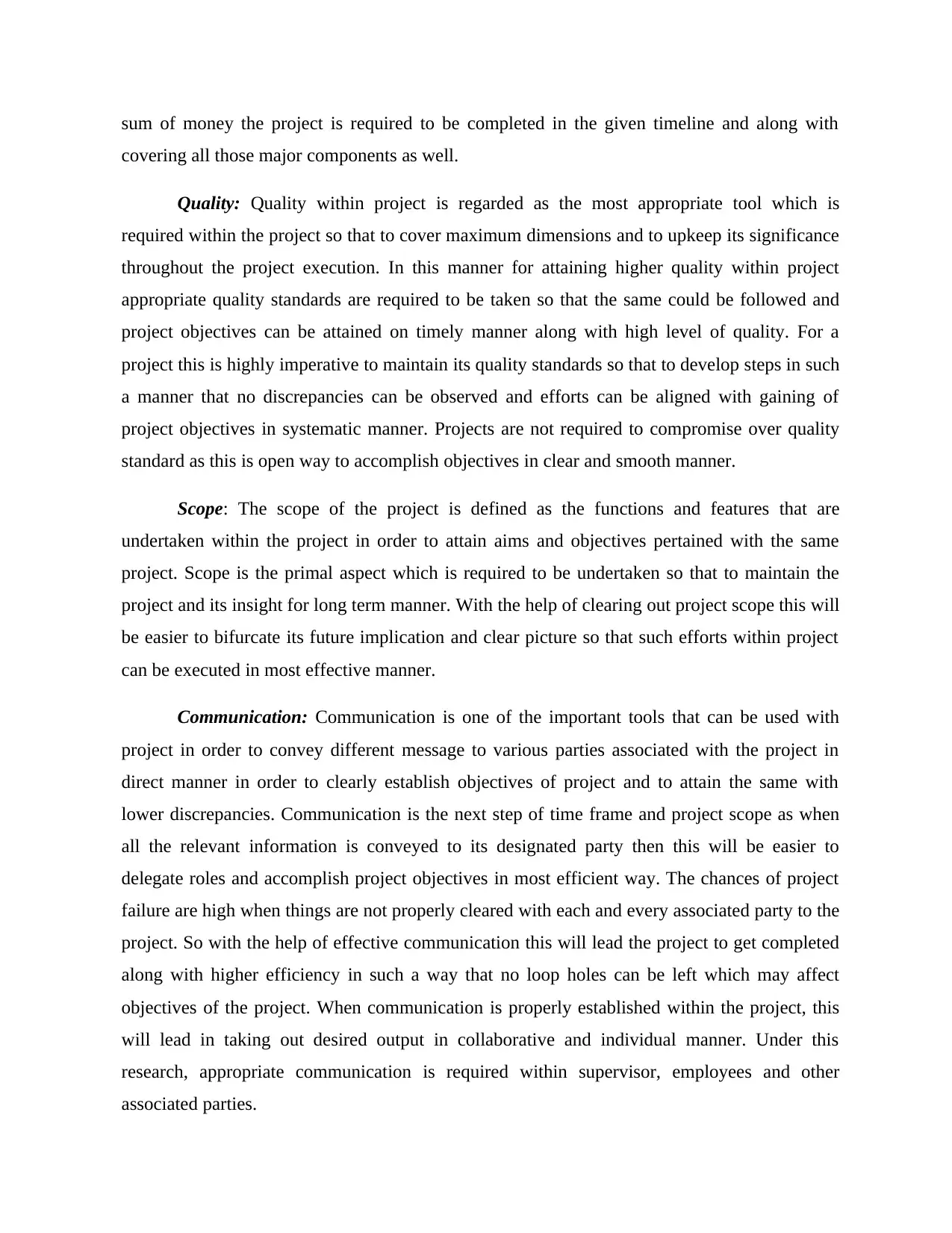
sum of money the project is required to be completed in the given timeline and along with
covering all those major components as well.
Quality: Quality within project is regarded as the most appropriate tool which is
required within the project so that to cover maximum dimensions and to upkeep its significance
throughout the project execution. In this manner for attaining higher quality within project
appropriate quality standards are required to be taken so that the same could be followed and
project objectives can be attained on timely manner along with high level of quality. For a
project this is highly imperative to maintain its quality standards so that to develop steps in such
a manner that no discrepancies can be observed and efforts can be aligned with gaining of
project objectives in systematic manner. Projects are not required to compromise over quality
standard as this is open way to accomplish objectives in clear and smooth manner.
Scope: The scope of the project is defined as the functions and features that are
undertaken within the project in order to attain aims and objectives pertained with the same
project. Scope is the primal aspect which is required to be undertaken so that to maintain the
project and its insight for long term manner. With the help of clearing out project scope this will
be easier to bifurcate its future implication and clear picture so that such efforts within project
can be executed in most effective manner.
Communication: Communication is one of the important tools that can be used with
project in order to convey different message to various parties associated with the project in
direct manner in order to clearly establish objectives of project and to attain the same with
lower discrepancies. Communication is the next step of time frame and project scope as when
all the relevant information is conveyed to its designated party then this will be easier to
delegate roles and accomplish project objectives in most efficient way. The chances of project
failure are high when things are not properly cleared with each and every associated party to the
project. So with the help of effective communication this will lead the project to get completed
along with higher efficiency in such a way that no loop holes can be left which may affect
objectives of the project. When communication is properly established within the project, this
will lead in taking out desired output in collaborative and individual manner. Under this
research, appropriate communication is required within supervisor, employees and other
associated parties.
covering all those major components as well.
Quality: Quality within project is regarded as the most appropriate tool which is
required within the project so that to cover maximum dimensions and to upkeep its significance
throughout the project execution. In this manner for attaining higher quality within project
appropriate quality standards are required to be taken so that the same could be followed and
project objectives can be attained on timely manner along with high level of quality. For a
project this is highly imperative to maintain its quality standards so that to develop steps in such
a manner that no discrepancies can be observed and efforts can be aligned with gaining of
project objectives in systematic manner. Projects are not required to compromise over quality
standard as this is open way to accomplish objectives in clear and smooth manner.
Scope: The scope of the project is defined as the functions and features that are
undertaken within the project in order to attain aims and objectives pertained with the same
project. Scope is the primal aspect which is required to be undertaken so that to maintain the
project and its insight for long term manner. With the help of clearing out project scope this will
be easier to bifurcate its future implication and clear picture so that such efforts within project
can be executed in most effective manner.
Communication: Communication is one of the important tools that can be used with
project in order to convey different message to various parties associated with the project in
direct manner in order to clearly establish objectives of project and to attain the same with
lower discrepancies. Communication is the next step of time frame and project scope as when
all the relevant information is conveyed to its designated party then this will be easier to
delegate roles and accomplish project objectives in most efficient way. The chances of project
failure are high when things are not properly cleared with each and every associated party to the
project. So with the help of effective communication this will lead the project to get completed
along with higher efficiency in such a way that no loop holes can be left which may affect
objectives of the project. When communication is properly established within the project, this
will lead in taking out desired output in collaborative and individual manner. Under this
research, appropriate communication is required within supervisor, employees and other
associated parties.
Paraphrase This Document
Need a fresh take? Get an instant paraphrase of this document with our AI Paraphraser
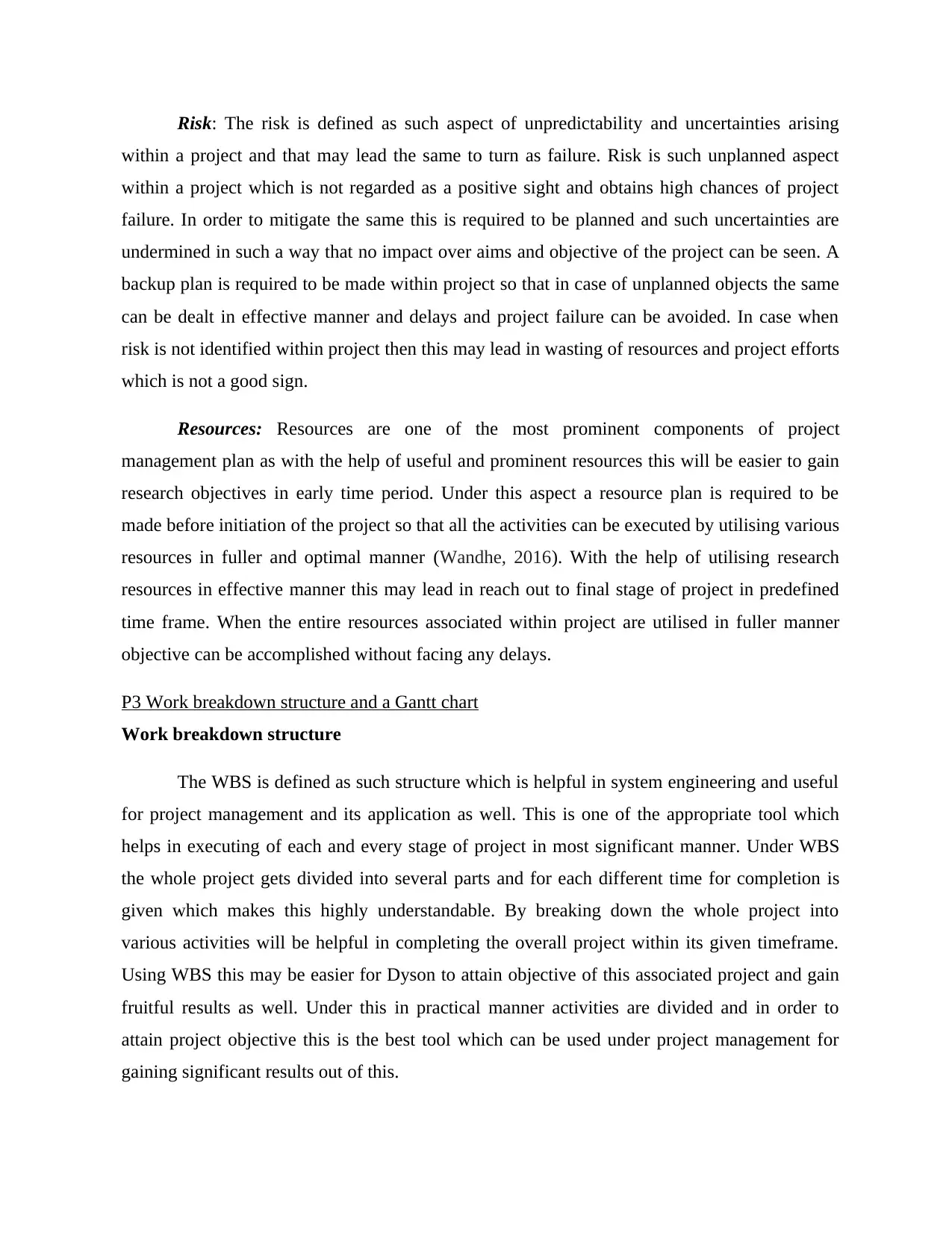
Risk: The risk is defined as such aspect of unpredictability and uncertainties arising
within a project and that may lead the same to turn as failure. Risk is such unplanned aspect
within a project which is not regarded as a positive sight and obtains high chances of project
failure. In order to mitigate the same this is required to be planned and such uncertainties are
undermined in such a way that no impact over aims and objective of the project can be seen. A
backup plan is required to be made within project so that in case of unplanned objects the same
can be dealt in effective manner and delays and project failure can be avoided. In case when
risk is not identified within project then this may lead in wasting of resources and project efforts
which is not a good sign.
Resources: Resources are one of the most prominent components of project
management plan as with the help of useful and prominent resources this will be easier to gain
research objectives in early time period. Under this aspect a resource plan is required to be
made before initiation of the project so that all the activities can be executed by utilising various
resources in fuller and optimal manner (Wandhe, 2016). With the help of utilising research
resources in effective manner this may lead in reach out to final stage of project in predefined
time frame. When the entire resources associated within project are utilised in fuller manner
objective can be accomplished without facing any delays.
P3 Work breakdown structure and a Gantt chart
Work breakdown structure
The WBS is defined as such structure which is helpful in system engineering and useful
for project management and its application as well. This is one of the appropriate tool which
helps in executing of each and every stage of project in most significant manner. Under WBS
the whole project gets divided into several parts and for each different time for completion is
given which makes this highly understandable. By breaking down the whole project into
various activities will be helpful in completing the overall project within its given timeframe.
Using WBS this may be easier for Dyson to attain objective of this associated project and gain
fruitful results as well. Under this in practical manner activities are divided and in order to
attain project objective this is the best tool which can be used under project management for
gaining significant results out of this.
within a project and that may lead the same to turn as failure. Risk is such unplanned aspect
within a project which is not regarded as a positive sight and obtains high chances of project
failure. In order to mitigate the same this is required to be planned and such uncertainties are
undermined in such a way that no impact over aims and objective of the project can be seen. A
backup plan is required to be made within project so that in case of unplanned objects the same
can be dealt in effective manner and delays and project failure can be avoided. In case when
risk is not identified within project then this may lead in wasting of resources and project efforts
which is not a good sign.
Resources: Resources are one of the most prominent components of project
management plan as with the help of useful and prominent resources this will be easier to gain
research objectives in early time period. Under this aspect a resource plan is required to be
made before initiation of the project so that all the activities can be executed by utilising various
resources in fuller and optimal manner (Wandhe, 2016). With the help of utilising research
resources in effective manner this may lead in reach out to final stage of project in predefined
time frame. When the entire resources associated within project are utilised in fuller manner
objective can be accomplished without facing any delays.
P3 Work breakdown structure and a Gantt chart
Work breakdown structure
The WBS is defined as such structure which is helpful in system engineering and useful
for project management and its application as well. This is one of the appropriate tool which
helps in executing of each and every stage of project in most significant manner. Under WBS
the whole project gets divided into several parts and for each different time for completion is
given which makes this highly understandable. By breaking down the whole project into
various activities will be helpful in completing the overall project within its given timeframe.
Using WBS this may be easier for Dyson to attain objective of this associated project and gain
fruitful results as well. Under this in practical manner activities are divided and in order to
attain project objective this is the best tool which can be used under project management for
gaining significant results out of this.
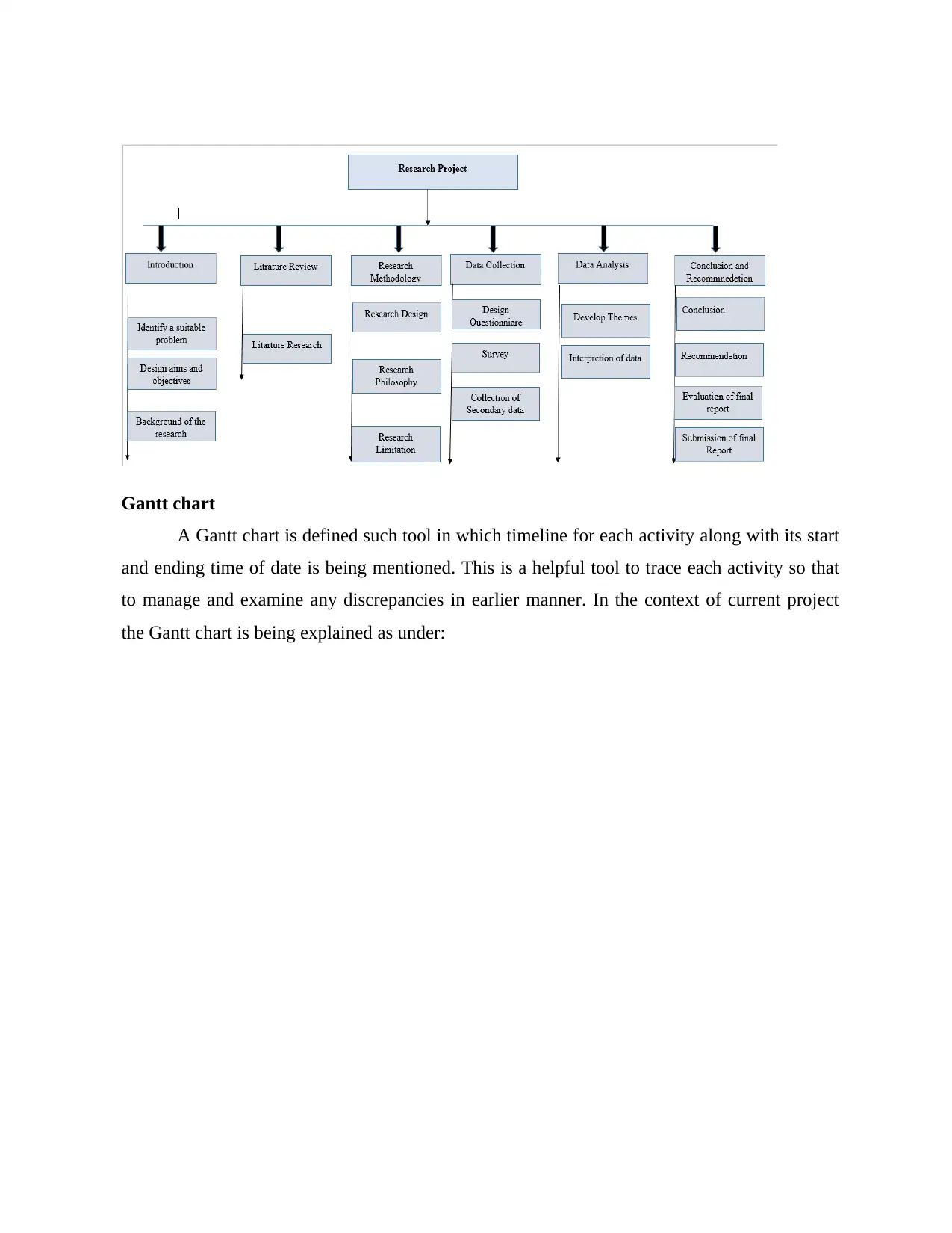
Gantt chart
A Gantt chart is defined such tool in which timeline for each activity along with its start
and ending time of date is being mentioned. This is a helpful tool to trace each activity so that
to manage and examine any discrepancies in earlier manner. In the context of current project
the Gantt chart is being explained as under:
A Gantt chart is defined such tool in which timeline for each activity along with its start
and ending time of date is being mentioned. This is a helpful tool to trace each activity so that
to manage and examine any discrepancies in earlier manner. In the context of current project
the Gantt chart is being explained as under:
⊘ This is a preview!⊘
Do you want full access?
Subscribe today to unlock all pages.

Trusted by 1+ million students worldwide
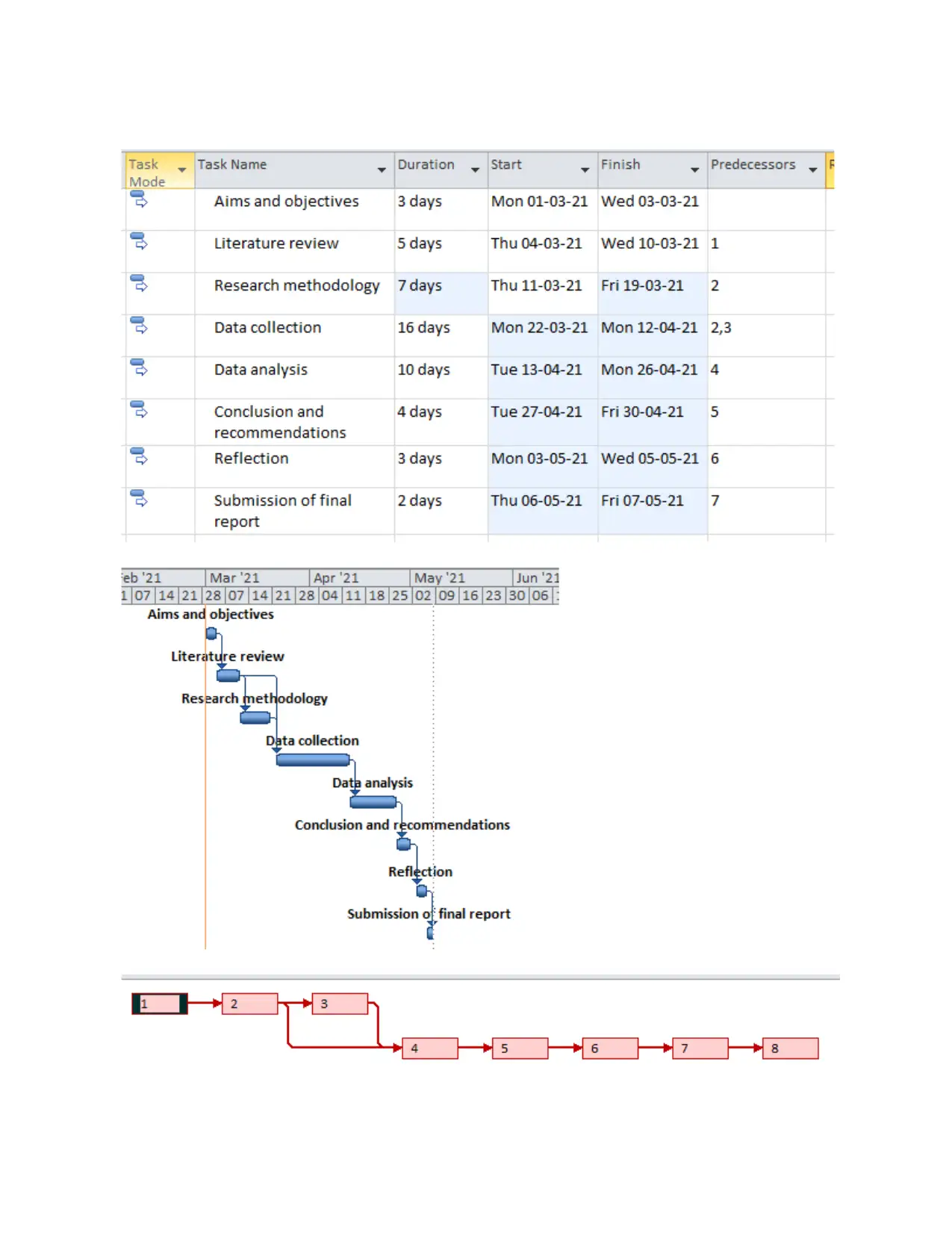
Paraphrase This Document
Need a fresh take? Get an instant paraphrase of this document with our AI Paraphraser
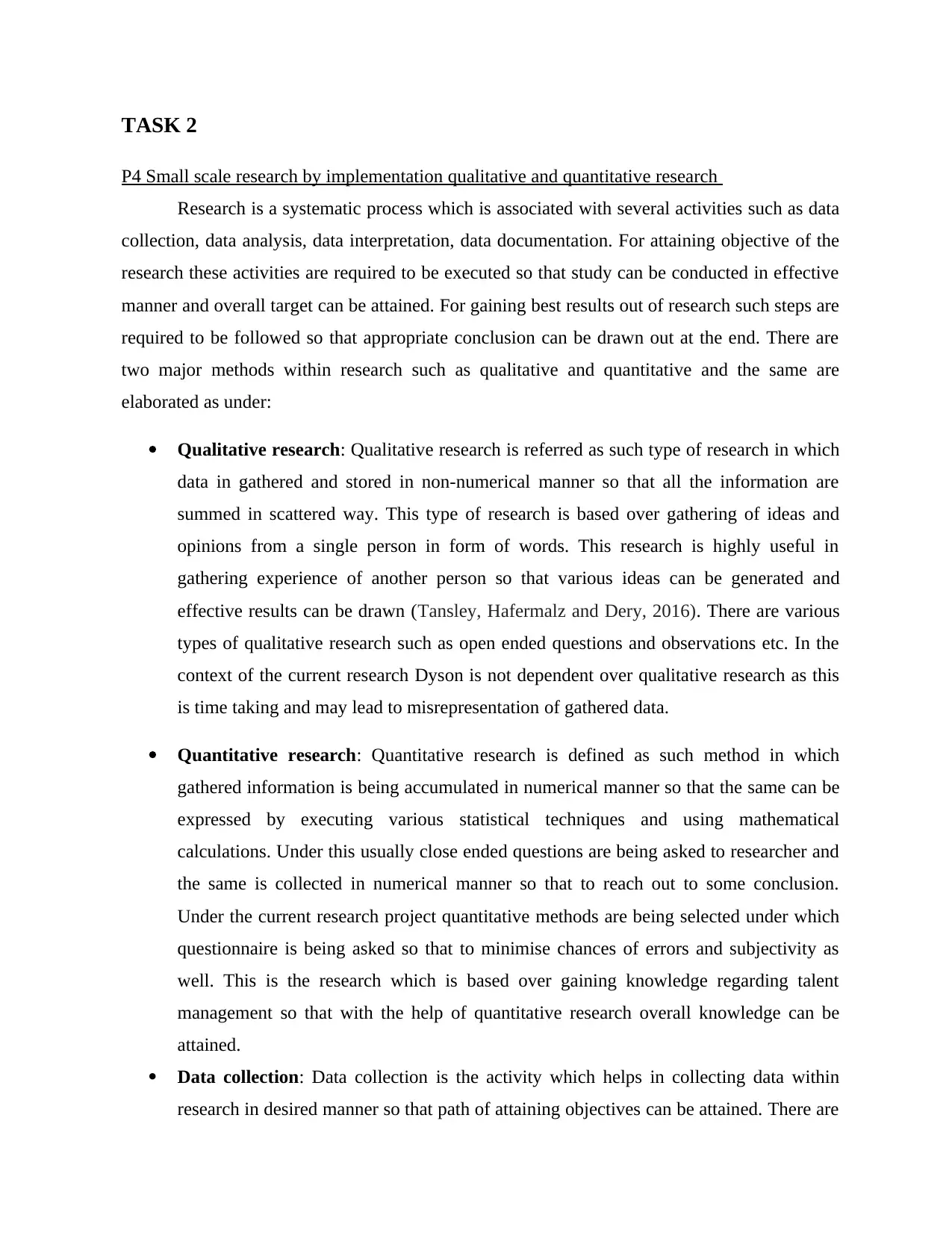
TASK 2
P4 Small scale research by implementation qualitative and quantitative research
Research is a systematic process which is associated with several activities such as data
collection, data analysis, data interpretation, data documentation. For attaining objective of the
research these activities are required to be executed so that study can be conducted in effective
manner and overall target can be attained. For gaining best results out of research such steps are
required to be followed so that appropriate conclusion can be drawn out at the end. There are
two major methods within research such as qualitative and quantitative and the same are
elaborated as under:
Qualitative research: Qualitative research is referred as such type of research in which
data in gathered and stored in non-numerical manner so that all the information are
summed in scattered way. This type of research is based over gathering of ideas and
opinions from a single person in form of words. This research is highly useful in
gathering experience of another person so that various ideas can be generated and
effective results can be drawn (Tansley, Hafermalz and Dery, 2016). There are various
types of qualitative research such as open ended questions and observations etc. In the
context of the current research Dyson is not dependent over qualitative research as this
is time taking and may lead to misrepresentation of gathered data.
Quantitative research: Quantitative research is defined as such method in which
gathered information is being accumulated in numerical manner so that the same can be
expressed by executing various statistical techniques and using mathematical
calculations. Under this usually close ended questions are being asked to researcher and
the same is collected in numerical manner so that to reach out to some conclusion.
Under the current research project quantitative methods are being selected under which
questionnaire is being asked so that to minimise chances of errors and subjectivity as
well. This is the research which is based over gaining knowledge regarding talent
management so that with the help of quantitative research overall knowledge can be
attained.
Data collection: Data collection is the activity which helps in collecting data within
research in desired manner so that path of attaining objectives can be attained. There are
P4 Small scale research by implementation qualitative and quantitative research
Research is a systematic process which is associated with several activities such as data
collection, data analysis, data interpretation, data documentation. For attaining objective of the
research these activities are required to be executed so that study can be conducted in effective
manner and overall target can be attained. For gaining best results out of research such steps are
required to be followed so that appropriate conclusion can be drawn out at the end. There are
two major methods within research such as qualitative and quantitative and the same are
elaborated as under:
Qualitative research: Qualitative research is referred as such type of research in which
data in gathered and stored in non-numerical manner so that all the information are
summed in scattered way. This type of research is based over gathering of ideas and
opinions from a single person in form of words. This research is highly useful in
gathering experience of another person so that various ideas can be generated and
effective results can be drawn (Tansley, Hafermalz and Dery, 2016). There are various
types of qualitative research such as open ended questions and observations etc. In the
context of the current research Dyson is not dependent over qualitative research as this
is time taking and may lead to misrepresentation of gathered data.
Quantitative research: Quantitative research is defined as such method in which
gathered information is being accumulated in numerical manner so that the same can be
expressed by executing various statistical techniques and using mathematical
calculations. Under this usually close ended questions are being asked to researcher and
the same is collected in numerical manner so that to reach out to some conclusion.
Under the current research project quantitative methods are being selected under which
questionnaire is being asked so that to minimise chances of errors and subjectivity as
well. This is the research which is based over gaining knowledge regarding talent
management so that with the help of quantitative research overall knowledge can be
attained.
Data collection: Data collection is the activity which helps in collecting data within
research in desired manner so that path of attaining objectives can be attained. There are
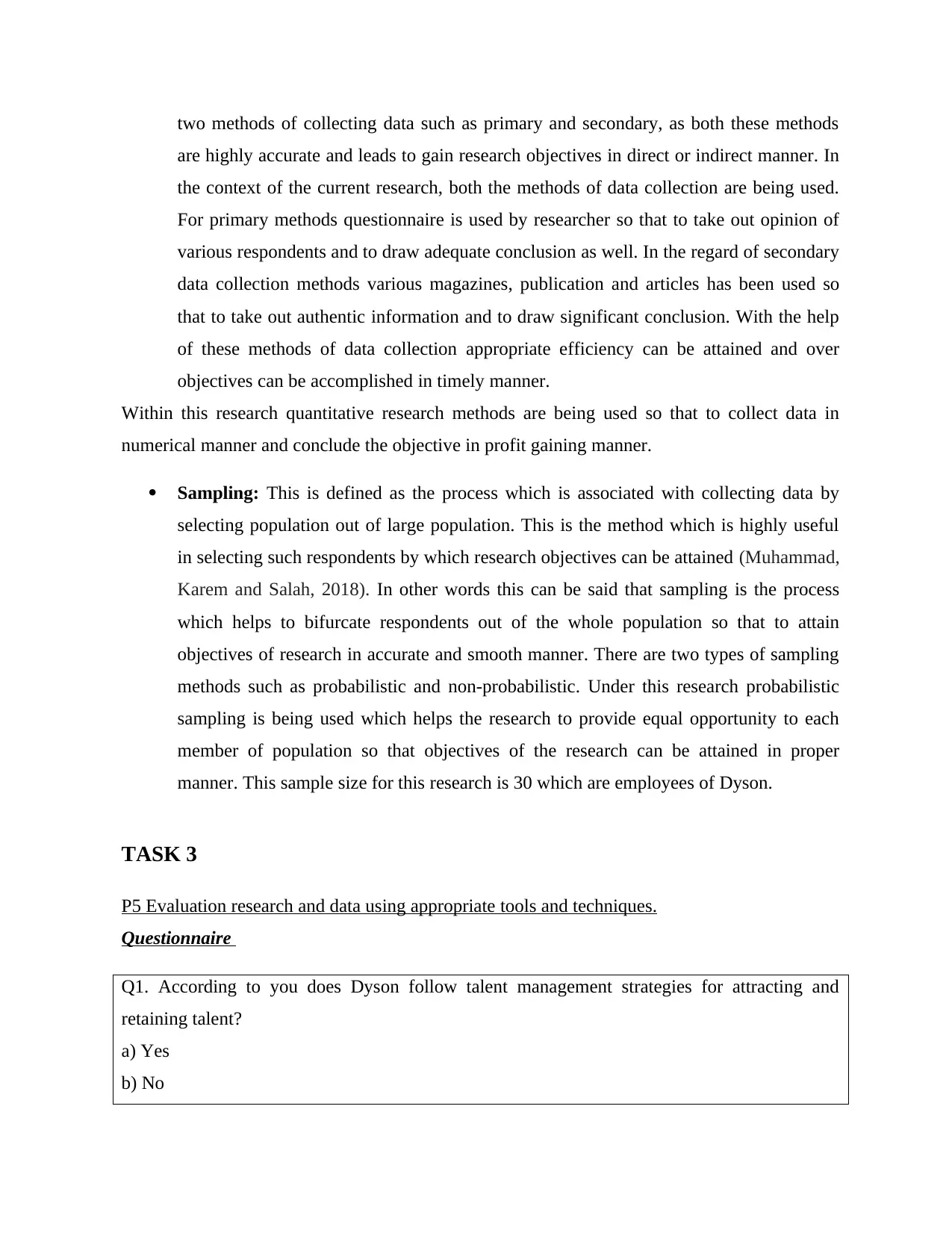
two methods of collecting data such as primary and secondary, as both these methods
are highly accurate and leads to gain research objectives in direct or indirect manner. In
the context of the current research, both the methods of data collection are being used.
For primary methods questionnaire is used by researcher so that to take out opinion of
various respondents and to draw adequate conclusion as well. In the regard of secondary
data collection methods various magazines, publication and articles has been used so
that to take out authentic information and to draw significant conclusion. With the help
of these methods of data collection appropriate efficiency can be attained and over
objectives can be accomplished in timely manner.
Within this research quantitative research methods are being used so that to collect data in
numerical manner and conclude the objective in profit gaining manner.
Sampling: This is defined as the process which is associated with collecting data by
selecting population out of large population. This is the method which is highly useful
in selecting such respondents by which research objectives can be attained (Muhammad,
Karem and Salah, 2018). In other words this can be said that sampling is the process
which helps to bifurcate respondents out of the whole population so that to attain
objectives of research in accurate and smooth manner. There are two types of sampling
methods such as probabilistic and non-probabilistic. Under this research probabilistic
sampling is being used which helps the research to provide equal opportunity to each
member of population so that objectives of the research can be attained in proper
manner. This sample size for this research is 30 which are employees of Dyson.
TASK 3
P5 Evaluation research and data using appropriate tools and techniques.
Questionnaire
Q1. According to you does Dyson follow talent management strategies for attracting and
retaining talent?
a) Yes
b) No
are highly accurate and leads to gain research objectives in direct or indirect manner. In
the context of the current research, both the methods of data collection are being used.
For primary methods questionnaire is used by researcher so that to take out opinion of
various respondents and to draw adequate conclusion as well. In the regard of secondary
data collection methods various magazines, publication and articles has been used so
that to take out authentic information and to draw significant conclusion. With the help
of these methods of data collection appropriate efficiency can be attained and over
objectives can be accomplished in timely manner.
Within this research quantitative research methods are being used so that to collect data in
numerical manner and conclude the objective in profit gaining manner.
Sampling: This is defined as the process which is associated with collecting data by
selecting population out of large population. This is the method which is highly useful
in selecting such respondents by which research objectives can be attained (Muhammad,
Karem and Salah, 2018). In other words this can be said that sampling is the process
which helps to bifurcate respondents out of the whole population so that to attain
objectives of research in accurate and smooth manner. There are two types of sampling
methods such as probabilistic and non-probabilistic. Under this research probabilistic
sampling is being used which helps the research to provide equal opportunity to each
member of population so that objectives of the research can be attained in proper
manner. This sample size for this research is 30 which are employees of Dyson.
TASK 3
P5 Evaluation research and data using appropriate tools and techniques.
Questionnaire
Q1. According to you does Dyson follow talent management strategies for attracting and
retaining talent?
a) Yes
b) No
⊘ This is a preview!⊘
Do you want full access?
Subscribe today to unlock all pages.

Trusted by 1+ million students worldwide
1 out of 31
Related Documents
Your All-in-One AI-Powered Toolkit for Academic Success.
+13062052269
info@desklib.com
Available 24*7 on WhatsApp / Email
![[object Object]](/_next/static/media/star-bottom.7253800d.svg)
Unlock your academic potential
Copyright © 2020–2025 A2Z Services. All Rights Reserved. Developed and managed by ZUCOL.





